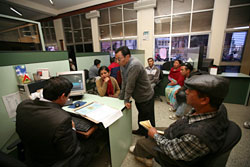 KIRAN PANDAY |
Given the poor business climate and soaring property prices, it is a fair guess? this cash is feeding the real estate bubble. Such a bubble driven by excess credit fueled liquidity is exactly what brought many US banks to their knees, and there is a good lesson there for us.
As property prices went up, banks in the US found increasing their real estate loan portfolio an easy way to boost earnings. They not only kept loans in their own balance sheet, but packaged them into securities which were sold to investors worldwide, further increasing the demand for mortgage loans. Borrowers were approved for loans they were not capable of paying and many jumped on the bandwagon assuming that real estate prices could only go up.
What initially started as a problem in the subprime loans or loans made to risky borrowers, has spread to prime loans as decreasing real estate prices and increasing unemployment rate are putting even credit worthy borrowers at risk. As a result, banks are now stuck with hundreds of billions of dollars in real estate loans, some of which are practically worthless, and are thus forced to book billions of dollars in losses. The massive loans are threatening the solvency of some US banks. The FDIC has seized more than 21 failing banks so far in 2009 alone.
We are inside a real estate bubble in Nepal, and this bubble could burst. Among other things, the excess cash available to drive prices higher may not be there in the future. The global economic slowdown is already impacting on the remittance flow into Nepal which will reduce the liquidity in the banking sector and the money chasing real
estate assets.
When the bubble bursts, not only will many Nepalis feel much poorer from reduced property prices, but their deposits in banks could also be at risk if banks that are overexposed to real estate lending face defaults, threatening their ability to meet obligations to depositors. The margin of error for Nepali financial institutions, and the public, is very small. Unlike most other countries, there is no established deposit insurance program in Nepal and it is questionable that Nepal Rastra Bank has the ability to manage a run on the banks.
Outstanding loans of commercial banks to the real estate sector grew at a staggering rate to Rs 17.9 billion in February from Rs 6.6 billion just a year earlier. The questions to ask the banks are: what percentage of outstanding loans is real estate related, including both direct and indirect loans where real estate asset is kept as collateral? How will the real estate price reduction affect the performance and recovery of these loans? Have the banks done a sensitivity test for the worst case scenario and are they adequately capitalised if that scenario materialises?
The government and Nepal Rastra Bank should also look into the feasibility of instituting a deposit insurance program up to a certain threshold. Such a program can be funded from the premium paid by the deposit-taking institutions and the premium should be based on the risk assessment of each participating institution.
It is not too late for Nepal, but it is time to ask tough questions to the banks and the regulator and focus on risk management so that when this real estate bubble ultimately bursts, it doesn't take the banking sector down with it.
Raju Sitaula is a banking professional based in New York.



